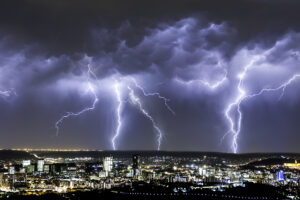Hydrothermal Explosion Sends Yellowstone Visitors Running

On July 23, 2024, a dramatic hydrothermal explosion rocked Yellowstone National Park, leaving visitors in awe and park staff assessing the damage. Here’s what happened:
The Incident
A large explosion erupted near the Biscuit Basin thermal area, close to Black Diamond Pool and approximately 2 miles northwest of the iconic Old Faithful geyser. Boiling water, mud, rocks, and steam shot high into the air, creating a massive black cloud that sent park visitors running for safety. Fortunately, there were no reported injuries, but the boardwalk suffered damage, with debris covering the walkway and fencing torn apart1.

The Science Behind It
Hydrothermal systems, like those found in Yellowstone, involve water heated by geothermal activity. When pressure drops underground, liquid water can suddenly flash into steam, causing an expansion. This rapid change in volume can lead to an explosion. While the video of this event appears significant, both the park and the U.S. Geological Survey (USGS) classified it as a small explosion. Larger hydrothermal explosions occur approximately every 700 years on average2.
The Hydrothermal System
Yellowstone sits atop a massive volcanic hotspot, resulting in a unique landscape dotted with geysers, hot springs, and mud pots. The park’s hydrothermal system is a delicate balance of heat, water, and pressure. Beneath the surface, magma heats groundwater, creating a vast network of interconnected channels. When these channels become blocked or pressure builds up, hydrothermal features can suddenly erupt.
The Biscuit Basin Area
The Biscuit Basin, named after biscuit-like mineral deposits, is home to several geysers and hot springs. Black Diamond Pool, one of the most striking features, boasts vibrant colors due to thermophilic bacteria thriving in its scalding waters. Visitors often marvel at the otherworldly beauty of this area, unaware of the hidden forces at play.
The Explosion
On that fateful day in July, as visitors strolled along the boardwalk near Black Diamond Pool, the ground trembled. Suddenly, a deafening roar echoed through the basin. Boiling water surged upward, carrying rocks, mud, and steam. The explosion was both awe-inspiring and terrifying. Fortunately, park rangers had already closed off the area, preventing any casualties.
Monitoring and Research
Yellowstone’s hydrothermal features are closely monitored by scientists. The U.S. Geological Survey (USGS) maintains an extensive network of sensors to detect changes in temperature, pressure, and ground movement. Despite these efforts, predicting hydrothermal events remains challenging. The explosion near Biscuit Basin serves as a reminder of nature’s power and unpredictability.
Remember, when you visit Yellowstone, you’re stepping onto a geological stage where Earth’s inner workings are on full display. Respect the signs, stay informed, and appreciate the wonder—and occasional danger—of this remarkable national park.
Safety Measures
Yellowstone National Park promptly closed the affected Biscuit Basin area for safety reasons. Scientists continue to study these dynamic geothermal systems, aiming to detect similar events before they happen. However, predicting hydrothermal explosions remains challenging due to their unpredictable nature1.
Remember, when visiting Yellowstone, marvel at its wonders but stay alert—nature’s surprises can be both breathtaking and powerful.








